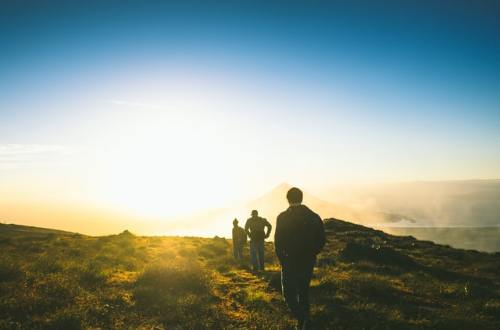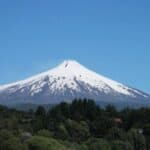


Hiking the Pacific ring of fire gives you plenty of possibilities to choose from – from hiking on the north in Alaska, to exploring the very south of South America. Either way, you will be experiencing an enormous adrenaline rush. Really unexpected from just hiking, don’t you think?

Because it represents a perfect mix of a dangerous, but yet safe activity, when all precautions are made, volcano hiking is one of the most popular activities for those who are looking for a “safe risk”.
Volcano hiking represents an activity where the hikers are exploring trails leading to active or inactive volcanos. This activity can be done in groups, or it can be performed on your own (which is not recommended, especially if you are exploring unofficial paths).
What separates volcano hiking from just regular hiking is that dash of adrenaline – you are walking on a territory where uncertainty is constant – you never know whether a certain volcano will erupt. Of course, safety measures are being undertaken before each tour, but just knowing that you are walking on the unstable ground makes you feel more engaged and interested in the activity.
Just as already mentioned, volcano hiking is the perfect mix for those who are looking for not-so-demanding physical activity, but yet want it to be thrilling. It is hard to make such a combination, but hiking the volcanos along the pacific ring of fire has both of them at once.
The reasons why would a person want to hike volcanos are numerous, but mostly because it is very exciting! Just imagine walking next to the volcano crater, knowing that for years and years that specific volcano has shown seismic activity, and even erupted. Along the way, you can see the formations the lava has made, and how it sculpted nature.
After each eruption, the terrain around the volcano inevitably changes, meaning that even though you will hike the same volcano, between two eruptions, you will never hike the same path twice.
Volcano hiking is not for those who just want to train and be in condition, it’s for those who seek to gain new experiences and to explore new sceneries. It’s the memories that will stay after you finish hiking, not the muscles you might have gained.
Overall, volcano hiking is not an activity that’s too demanding, meaning that you will be able to do it with ease unless you choose some really steep paths, for which you will need to be in condition. All you need is to take your favorite pair of hiking shoes with you and get ready to explore the volcanos!





Volcano hiking is an activity that is performed hiking on “dead” (inactive) volcanos, or it can be performed in close proximity of the active ones. Either way, the surroundings depending on the location of the activity you choose.
If you choose to go hiking somewhere north of the Pacific ring of fire, the climate may be very cold, meaning you will need some more serious equipment to perform this activity. The more south you go, the warmer it gets, thus it becomes easier to finish your hike.
Although volcano hiking can be performed all year round, the peak of the season is from late spring to early fall. This is the time most hikers choose to explore the volcanos, mostly because the weather is nice, and no heavy rainings are expected.
Beware that some of the most popular hiking places, like Mount St. Helens, require the hikers to obtain a hikers permit during the peak season, between April 1st and October 31st.
If you truly wish to experience the thrill and joy of volcano hiking, you must try hiking along the Pacific ring of fire. Pacific ring of fire is a name for a belt of a very dense concentration of active volcanos. It is a place where tectonic plates meet and cause earthquakes and eruptions.
When we talk about North and South America, the Pacific ring of fire stretches alongside the west coast, from the north all the way to the south.

One of the most popular places for volcano hiking lies in the very center of the Pacific ring of fire and is called the Masaya Volcano.
The Masaya Volcano is one of two active volcanos located in the Masaya Volcano National Park in Nicaragua, and it quickly gained its popularity by a very special feature they offer. After you finish your volcano hike during the day, you can choose to go and explore the volcano during the night. There is a special tour, where for only $10, you can go up to the crater of the volcano at night.
This is a very special thing to experience because the Masaya Volcano actually has an active lava lake, so during the night, you can enjoy looking at bubbling lava, under the sky filled with stars.
Due to the fact that there is a live lava lake, many of the hiking paths are closed due to safety reasons, but there are few of them that still allow you to explore and enjoy this volcano to the fullest.

Another very popular volcano to hike is the Arenal volcano located in the Arenal Volcano National Park in Costa Rica. This volcano had its last eruption in 2010, but you can still hear the lava under the ground, as it is preparing for another eruption.
Since this volcano is considered to be dangerous, you are not allowed to hike the actual volcano structure, but you are obliged to follow marked paths along the way, that will allow you to get to the volcano close enough.

If you choose to go a little bit south, to Chile, you will find another volcano interesting to hikers – the Villarica volcano. It is the most active volcano in this country, and just like the Masaya volcano, it is also featuring a lava lake in its crater.
Just to put as a disclaimer, having a lava lake formed in the crater is a very unique scenery you can see and explore due to the fact that only a few volcanos in the world have it.
Villarica is only for those who are experienced since the hike can be very tough. That’s why having a guided tour and equipment is a must, especially if you are just a beginner. Regarding the equipment, during the winter ice can form along the path, so you will need to have winter boots and clothing ready.

Last, but not least, we will mention the third most active volcano in the world – the Cotopaxi volcano located in Ecuador. It is the second-highest mountain in Ecuador, with its highest peak at 19.300ft, meaning that the hike will not be an easy task to do.
However, if you still choose to go and explore this beautiful masterpiece, beware that you might need to hire a guide to help you with the icy parts of the volcano. Since it can be dangerous due to the unpredictability of the eruption, never go hiking Cotopaxi on your own, without an expert.
Most risks associated with volcano hiking have nothing to do with the hiking itself, but rather with the place and time where and when you choose to go hiking. If you are a beginner, it is recommended to take less dangerous trails and to always go with a tour guide.
If you are aiming for more adrenaline, make sure to bring some safety equipment with you, and some signalizing equipment in case something happens.
Depending on the region you go volcano hiking, you might encounter:
This is a possibility when you go hiking in remote areas. If you do encounter a potentially dangerous wild animal, don’t panic and remain calm – that is the fastest way for the animal to lose interest in you, and go away on its own.



In general, volcano hiking is considered to be an activity everyone can perform. Regardless of whether you are just a beginner or a very advanced hiker, there are volcano paths and trials adjusted to everyone’s physical fitness.
Beginners are usually expected to hike a 10-mile path, with little to no steepness, while advanced hikers can choose to go extreme – hiking the ice tops of volcanos. In both cases, some level of endurance is expected and recommended to have, especially because volcano hiking is pretty similar to mountain hiking, which can be very demanding during the winter and summertime.
There is no specific training regimen when you are preparing for hiking. The best advice is to choose the path according to your current health and physical fitness. However, there are some exercises you can do in order to improve your readiness for the hike.
Most of the volcano parks where you choose to hike have their own apps with all paths you can take, that is also available offline. Make sure to download the specific app you may need before you go for the hike.
Price:
Since hiking is a very specific activity to take because it requires little to no gear, the gear cost can be really minimized, since all the supporting gear we all have at our homes. However, if you don’t have some of the items we’ve mentioned, here we will post their prices.
All of the aforementioned gear can cost somewhere between $10-20, on average. Of course, if you are planning to go on a serious volcano hike, where you opt out to hike the ice top as well, you will also need professional mountaineering equipment, which can cost at least $50-100 for basic pieces.
Price:
Since volcano hiking is usually a daily activity, here is the list of food and drinks you need to take with you:
All of this could approximately cost around $10-20, per day and per person.
Price:
Reaching the volcanos along the pacific ring of fire is very easy because they are accessible by all means of transportation. The cost of transportation depends on where you are coming from.
On the other hand, some of the national parks where the volcanos are located can charge you some transportation costs for the transport from the entrance to the hiking paths, and it can be from $10 up to $30 (mostly for late-night rides).
Price:
If you are traveling somewhere remotely, the cost of accommodation can vary depending on whether you are accommodated in a hotel or in a hostel. If you choose to stay in a hotel, a bed&breakfast will cost you at least $20 per night, while the hostel will be probably around $10.
Another option is to explore nearby camping places, but beware that they also require an entrance fee, which can be somewhere from $5-20 on average.
Price:
Most of the volcanos are located in the center of national parks, which will require you to pay an entrance fee in order to gain access to the volcano hiking site. This fee depends on where you are located but is somewhere between $20-50.
At some places, you can even go explore lava hiking trails, where you will be walking on real lava. Although it sounds really fun, it can be very dangerous if you don’t follow the instructions given by the guide. What no one expects are the sharp parts of lava, and that’s where the most injuries happen. Lava is not just a squishy and soft surface – it can have hard parts as well.


Yes, and it is recommended to do so! It is safer when you go hiking in a group, and it is also more fun!
There is no age restriction, however, it is not recommended for children under 12 to go volcano hiking, due to many potential hazards. Those who are having any breathing or heart issues should skip going volcano hiking.
In the wild! There are no bathrooms along the way, so it’s recommended to go to the bathroom before you reach the track. If you feel the urge along the way and can’t hold it, nature is at your disposal.
See Notes on transportation in the Finances & Budget section.
See notes in the “Where and When to Go?” section.
Yes, each volcano where hiking is available has its own guided tours which are recommended for everyone, especially beginners.
Make sure to have the right signaling equipment with you. First, check whether you have a phone signal, and if you do, send your location and the rescue team will find you quickly.
Copyright 2021 – Adventure on the Cheap (SRVS)
